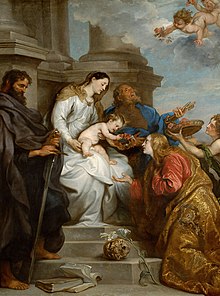Saint Rosalia
Saint Rosalia | |
|---|---|
 Santa Rosalia, depicted on the right, before St. Mary by Anthony van Dyck | |
| Virgin | |
| Born | 1130 Palermo, Kingdom of Sicily |
| Died | 1166 (aged 35–36) Mount Pellegrino, Kingdom of Sicily |
| Venerated in | Roman Catholic Church |
| Feast | July 14 (Festino), September 4 (Pilgrimage on Monte Pellegrino) |
| Attributes | Depicted as a young woman, sometimes holding a cross, book, or skull, and also a spray of lilies. Some images show her holding a chisel and hammer with which she carved her dedication (see main story). She is also seen wearing a crown of roses, attended by winged angels, and often with a view through a cave opening of Palermo Harbour. |
| Patronage | Palermo; El Hatillo; Zuata Anzoátegui; Italian fishermen of Monterey, California |
Saint Rosalia (1130–1166), also called La Santuzza or "The Little Saint", and in local dialect as "Rusalia", is the patron saint of Palermo in Italy, and three towns in Venezuela: El Hatillo, Zuata, and Anzoátegui.
Biography

Rosalia was born of a Norman noble family that claimed descent from Charlemagne. Devoutly religious, she retired to live as a hermit in a cave on Mount Pellegrino, where she died alone in 1166. Tradition says that she was led to the cave by two angels. On the cave wall she wrote "I, Rosalia, daughter of Sinibald, Lord of Roses, and Quisquina, have taken the resolution to live in this cave for the love of my Lord, Jesus Christ." The feast of Saint Rosalia is on September 4th. [1] In 1624, a plague beset Palermo. During this hardship Saint Rosalia appeared first to a sick woman, then to a hunter, to whom she indicated where her remains were to be found. She ordered him to bring her bones to Palermo and have them carried in procession through the city.
The hunter climbed the mountain and found her bones in the cave as described. He did what she had asked in the apparition. After her remains were carried around the city three times, the plague ceased. After this Saint Rosalia was venerated as the patron saint of Palermo, and a sanctuary was built in the cave where her remains were discovered.[2]
Upon examination by a renowned geologist and palaeontologist, William Buckland, the bones of St Rosalia were thought to be those of a goat.[3]
Veneration

The celebration, called the festino, is still held each year on July 15, and continues into the next day. It is still a major social and religious event in Palermo. In 1995, 1996, 1997[4] and 2001 the celebration has been produced by Studio Festi.
Also on September 4 there is an event related to the festino and St. Rosalia; a tradition of walking barefoot from Palermo up to Mount Pellegrino. In Italian American communities in the United States, the July feast is generally dedicated to Our Lady of Mount Carmel while the September feast, beginning in August, brings large numbers of visitors annually to the Bensonhurst section of Brooklyn in New York City.
In biology
Saint Rosalia was proposed as the patron saint of evolutionary studies in a paper by G.E. Hutchinson.[5] This was due to a visit he paid to a pool of water downstream from the cave where St. Rosalia's remains were found, where he developed ideas based on observations of water boatman.[6]
See also
References
- ^ http://www.catholic.org/saints/saint.php?saint_id=157
- ^ For the great expansion of Rosalia's popular cult in Italy as a result of the 1624 plague, see Franco Mormando, "Response to the Plague in Early Modern Italy: What the Primary Sources, Printed and Painted, Reveal" in Hope and Healing: Painting in Italy in a Time of Plague, 1500–1800, ed. G. Bailey, P. Jones, F. Mormando, and T. Worcester, Worcester, Massachusetts: The Worcester Art Museum,2005, pp. 32–34.
- ^ Switek, Brian (9 February 2009). "The Father, the Son, and the Holy Goat". ScienceBlogs. Retrieved 15 July 2015.
- ^ Municipality of Palermo, 373°festino – Clips from the official video
- ^ Hutchinson, G. E. (1959-05-01). "Homage to Santa Rosalia or Why Are There So Many Kinds of Animals?". The American Naturalist. 93 (870): 145–159. doi:10.1086/282070. ISSN 0003-0147. JSTOR 2458768.
- ^ Hutchinson, G.E. (May–June 1959). "Homage to Santa Rosalia or Why Are There So Many Kinds of Animals?". The American Naturalist. 93 (870): 145–149. doi:10.1086/282070. Retrieved 15 July 2015.
External links
 Herbermann, Charles, ed. (1913). "St. Rosalia". Catholic Encyclopedia. New York: Robert Appleton Company.
Herbermann, Charles, ed. (1913). "St. Rosalia". Catholic Encyclopedia. New York: Robert Appleton Company.
